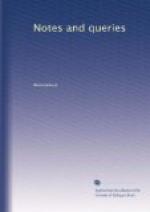“(1705.) (------------------) Memoranda. 29. Mar.—Pandoxe. 6. Apr.—relinit. 28. Apr.—relinit. 3. May.—Pandoxe. 17. May.—relinit. 31. May.—relinit. 5. Iun.—Pandoxe.”
and at the top of the list the figure of a barrel.
I should be glad if any of the readers of your paper could tell me the meaning of the word Pandoxare? Whatever it was, it took place about once a month.
H.B.
[Ducange explains Pandoxare
“Cauponum exercere, agere; cerevisiam
venum exponere atque
adeo conficere.”]
Lord Bacon’s Metrical Version of the Psalms.—In old Izaak Walton’s Life of George Herbert, I find the following passage:—
“He (i.e. Lord Bacon) thought him so worthy of his friendship, that having translated many of the Prophet David’s Psalms into English verse, he made George Herbert his patron by a public dedication of them to him, as the best judge of divine poetry.”
Can any one of your numerous readers inform me if these “Metricals” are known?—if so it will greatly oblige
A CORNISHMAN.
Festival of St. Michael and All Angels.—Can any of your readers inform me why double second lessons are appointed in the Book of Common Prayer for the Festival of St. Michael and All Angels? First, among the “lessons proper for Holy-days,” we have, at Matins, Acts xii. to v. 20.; and at Evensong, Jude, v.6 to v.16.: and then in the Calendar, coming in ordinary course, we have, at Morning Prayer, Mark. ii.; and at evening, 1 Cor. xiv. In every other case, where the second lessons are proper, there are none appointed in the Calendar in ordinary course.
K.M.P.
Wood-cut Likeness of Luther and Erasmus.—Perhaps you will permit me to inquire what are the earliest wood-cut likenesses of Luther and Erasmus. Am I right in supposing that the image of the great Reformer is found for the first time on the verse of the title-page of his treatise De Captivitate Babylonica Ecclesiae, 4to., s.l.v.a.; and that the wished-for representation of Erasmus may be seen in the small octavo volume, entitled Bellaria Epistolarum Erasmi Rot. et Ambrosii Pelargi vicissim missarum, Colon. 1539? Some of your readers will doubtless be acquainted with what seems to be a very accurate and complete performance, the Vita D. Martini Lutheri Nummis atque Inconibus illustrata, studio M. Christiani Juncker, 8vo., Francof. 1699. In this work (p.129.) there is an impression of a medal on which was exhibited the Imago ad vivam effigiem expressa of Erasmus, anno 1531.
R.G.
Anglo-Saxon “Lay of the Phoenix.”—Has any edition of the Lay of the Phoenix been published, besides the English version in the Archaeologia, vol. 30, and that which bears the date, “Copenhagen, Grundtvig, 1840, 8vo”? Can any light be thrown on the doubts respecting the era of the author of this lay? And is there any published edition of the hexameter poem by Lactantius, which is said by Stephens to have suggested the first idea of this beautiful Anglo-Saxon poem?




